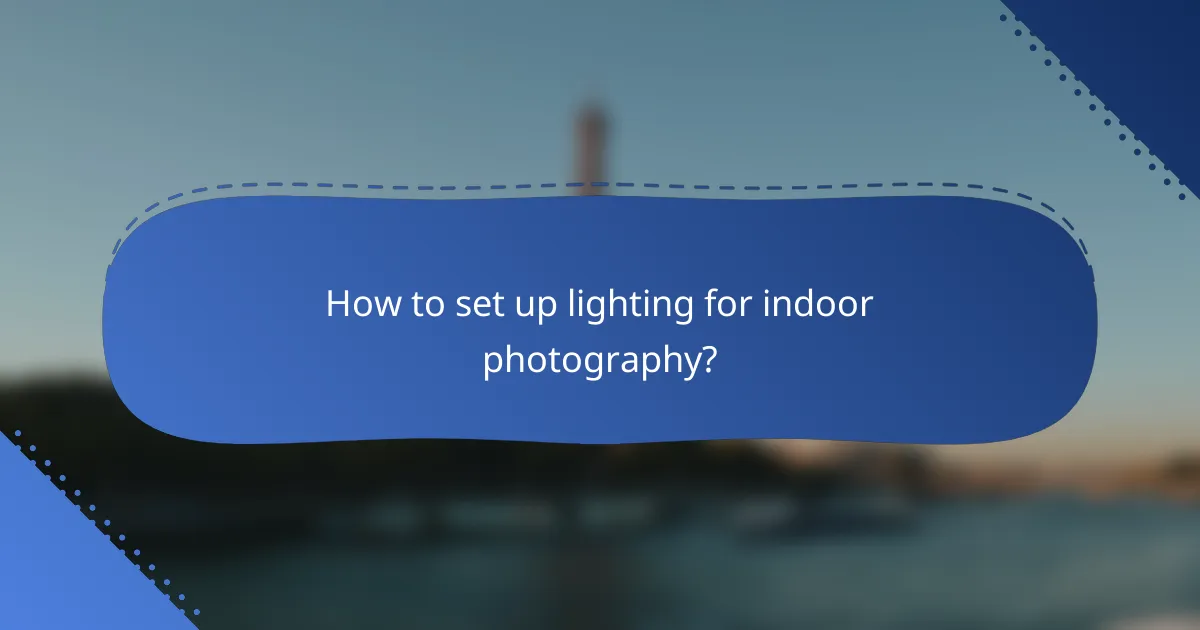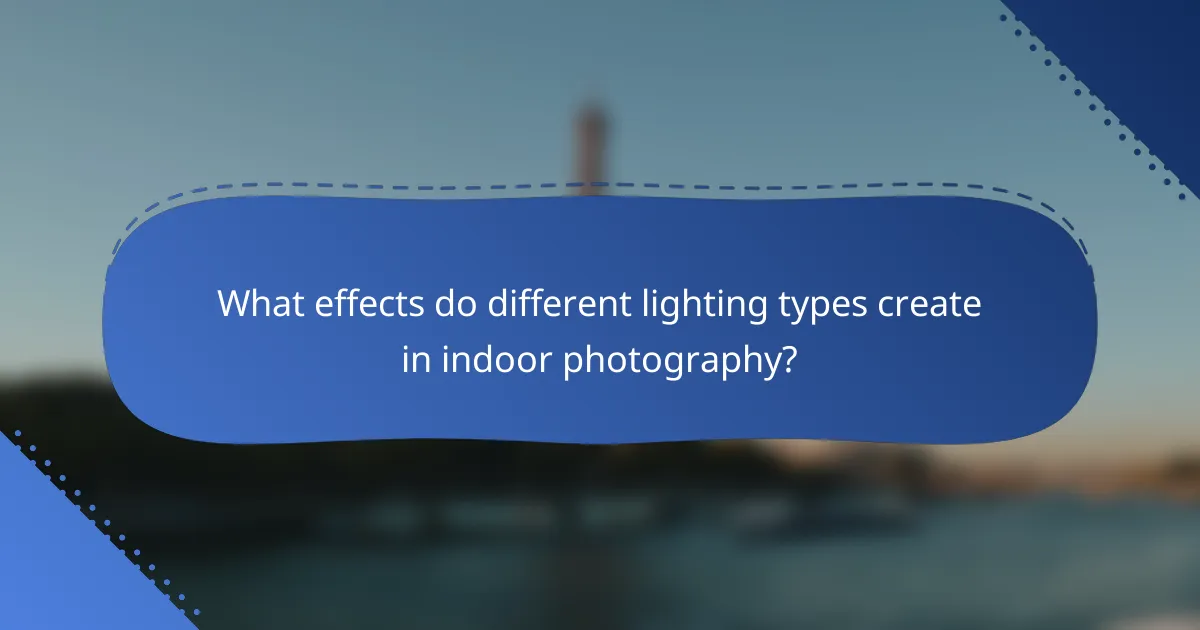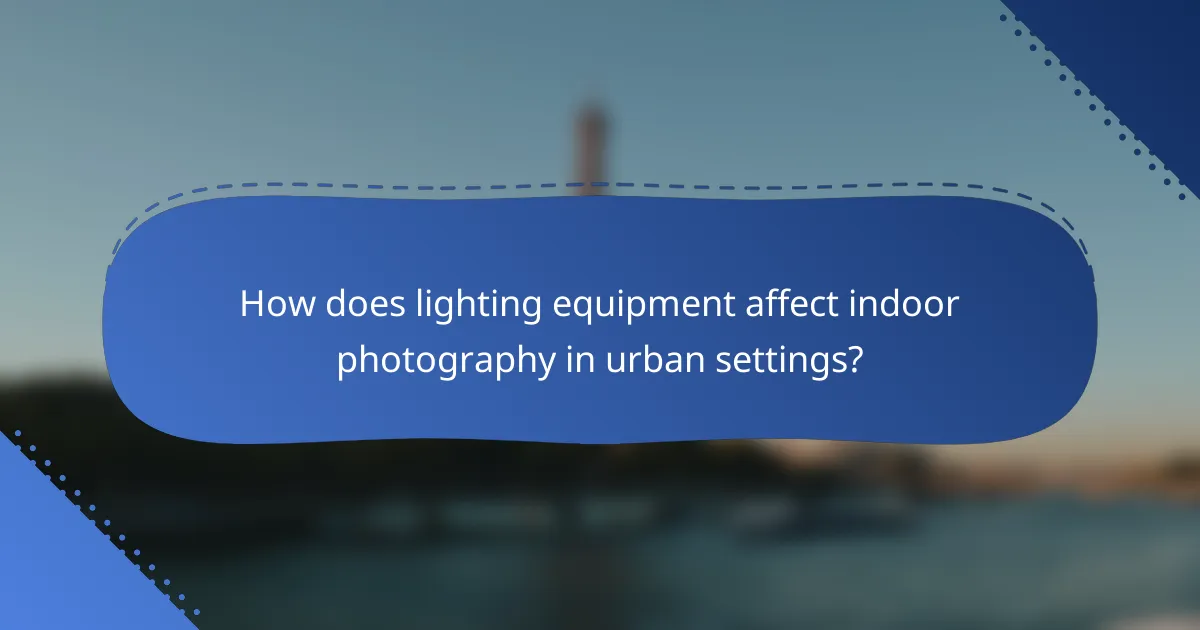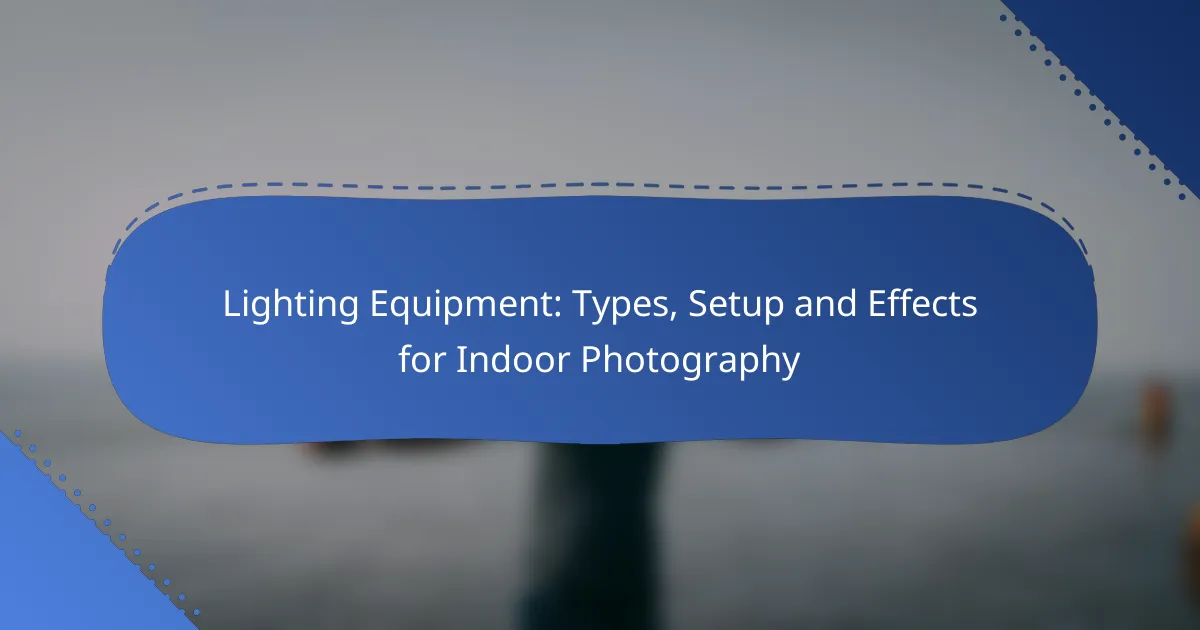Indoor photography relies heavily on effective lighting equipment, including continuous lights, flash units, LED panels, softboxes, and ring lights, each offering distinct advantages for various styles. Setting up your lighting involves careful consideration of its type, position, and interaction with the subject, which can significantly enhance the mood and detail of your images. By mastering the effects of different lighting types, you can transform the atmosphere and quality of your photographs, achieving your artistic vision.

What types of lighting equipment are best for indoor photography?
The best types of lighting equipment for indoor photography include continuous lighting, flash lighting, LED panels, softboxes, and ring lights. Each type offers unique benefits and considerations, making them suitable for different photography styles and environments.
Continuous lighting
Continuous lighting provides a steady light source, allowing photographers to see how the light affects their subject in real-time. This type of lighting is particularly useful for video and portrait photography, as it helps in achieving consistent exposure and color balance.
When using continuous lighting, consider the wattage and color temperature of the bulbs. Common options include fluorescent, tungsten, and LED lights, each offering different qualities of light. For indoor settings, aim for a color temperature around 5000K to 6000K for a natural look.
Flash lighting
Flash lighting delivers a brief burst of light, which can freeze motion and create dramatic effects. This type is ideal for capturing sharp images in low-light conditions, making it a favorite among event and portrait photographers.
When using flash, consider the sync speed of your camera and the power of the flash unit. Many photographers use external flash units or speedlights to enhance their lighting setup. Remember to adjust your camera settings to avoid overexposure, especially in bright environments.
LED panels
LED panels are versatile lighting tools that provide adjustable brightness and color temperature. They are lightweight, energy-efficient, and can be easily mounted or positioned for various shooting angles.
For indoor photography, look for LED panels with a high Color Rendering Index (CRI) to ensure accurate color reproduction. Many panels also offer features like dimming and color adjustment, allowing you to tailor the light to your specific needs.
Softboxes
Softboxes diffuse light, creating a softer and more flattering illumination for subjects. They help reduce harsh shadows and are commonly used in portrait and product photography.
When setting up softboxes, consider their size and shape. Larger softboxes produce softer light, while smaller ones create more focused beams. Position them at a 45-degree angle to your subject for optimal results, and use multiple softboxes for even lighting across the scene.
Ring lights
Ring lights provide even, shadow-free lighting that is especially popular for beauty and macro photography. Their circular design allows for uniform illumination around the lens, highlighting details without harsh shadows.
When using a ring light, position it directly in front of your subject for the best effect. Many ring lights come with adjustable brightness and color temperature settings, making them suitable for various indoor environments. They are also portable, making them easy to set up and use in different locations.

How to set up lighting for indoor photography?
To set up lighting for indoor photography, consider the type of lighting, its position, and how it interacts with your subject. Proper lighting enhances the mood and detail of your images, making it essential to experiment with different setups to achieve the desired effect.
Three-point lighting setup
The three-point lighting setup is a classic method that involves three light sources: the key light, fill light, and back light. The key light is the main source, positioned at a 45-degree angle to the subject, providing the primary illumination.
The fill light softens shadows created by the key light and is typically placed on the opposite side, at a lower intensity. The back light, positioned behind the subject, adds depth by creating separation from the background, enhancing the three-dimensional feel of the image.
Using reflectors
Reflectors are a cost-effective tool to manipulate light in indoor photography. They bounce light back onto the subject, filling in shadows and creating a more balanced exposure. Common materials for reflectors include white foam boards, silver or gold fabrics, and even professional reflector panels.
When using reflectors, position them at angles that direct light onto the subject without causing harsh glare. Experiment with different colors and surfaces to see how they affect the warmth and tone of your images.
Positioning lights for shadows
Positioning lights effectively is crucial for controlling shadows in indoor photography. To create soft shadows, place lights closer to the subject and use diffusers to soften the light. This technique minimizes harsh lines and creates a more flattering look.
For dramatic effects, position lights further away or use harder light sources. Adjusting the angle of the light can also change the shadow’s direction and intensity, allowing for creative control over the final image. Always consider the subject’s features and the desired mood when positioning your lights.

What effects do different lighting types create in indoor photography?
Different lighting types can dramatically influence the mood, texture, and overall quality of indoor photographs. Understanding how soft and hard light, as well as color temperature, affect your images is essential for achieving the desired artistic effect.
Soft light effects
Soft light creates gentle shadows and reduces harsh contrasts, resulting in a flattering and even illumination. This type of lighting is often achieved using diffusers, softboxes, or natural light from windows.
When using soft light, subjects appear smoother and more natural, making it ideal for portraits and product photography. To enhance soft light effects, position your light source at a distance and use reflective surfaces to bounce light onto your subject.
Hard light effects
Hard light produces sharp shadows and high contrast, which can create dramatic and striking images. This lighting is typically generated from direct sources like bare bulbs or the sun at midday.
Utilizing hard light can emphasize textures and details, making it suitable for architectural photography or artistic portraits. To control hard light, consider using flags or grids to direct the light and soften the shadows where necessary.
Color temperature impact
Color temperature affects the mood and tone of your indoor photographs, with warmer temperatures (around 3000K) creating a cozy feel and cooler temperatures (around 6000K) producing a more clinical or modern look. Adjusting the color temperature can enhance skin tones or emphasize certain colors in your composition.
When working with artificial lights, be mindful of the color balance settings on your camera. Using gels or adjusting your white balance can help achieve the desired color temperature, ensuring your images reflect the intended atmosphere.

What are the key considerations for choosing lighting equipment?
When selecting lighting equipment for indoor photography, consider your budget, the space available, and the mood or style you wish to achieve. Each of these factors plays a crucial role in determining the right setup for your specific needs.
Budget constraints
Your budget is a primary factor in choosing lighting equipment. Prices can vary widely, from affordable continuous lights to high-end strobes. Establish a clear budget range, typically between a few hundred to several thousand dollars, depending on your requirements.
Consider starting with essential equipment like softboxes or LED panels, which can be found at reasonable prices. As you gain experience and understand your needs better, you can invest in more advanced lighting options.
Space availability
The space where you will be shooting significantly influences your lighting choices. In smaller areas, compact lights and portable setups are ideal, while larger spaces allow for more extensive lighting arrangements. Assess the dimensions of your shooting area to determine the type and number of lights you can effectively use.
Utilizing adjustable stands and collapsible softboxes can help maximize your space. Ensure that your lighting setup does not overcrowd the area, which can hinder your ability to move around and capture the desired shots.
Desired mood and style
The mood and style you want to convey in your photographs will guide your lighting equipment selection. For a bright and airy feel, soft, diffused lighting is essential, while dramatic shadows and contrast may require harsher light sources. Think about the emotional impact you want your images to have.
Experiment with different lighting setups to achieve your desired effect. For instance, using colored gels can add creative flair, while adjusting the angle and distance of your lights can dramatically change the mood of your shots. Always test your lighting before the actual shoot to ensure it aligns with your vision.

How does lighting equipment affect indoor photography in urban settings?
Lighting equipment significantly influences indoor photography in urban environments by shaping the mood, clarity, and overall quality of images. Proper use of both natural and artificial light can enhance the aesthetic appeal and detail of urban scenes, making them more engaging.
Natural light integration
Integrating natural light into indoor photography can create a soft, inviting atmosphere. Utilize windows and skylights to maximize daylight, especially during golden hours—early morning or late afternoon—when the light is warm and diffused.
Consider the direction of sunlight and how it interacts with your subject. Position your camera to capture the light’s angle, which can add depth and dimension to your photos. Avoid harsh midday sunlight, as it can create unflattering shadows.
Artificial light sources
Artificial lighting is essential for controlling exposure and mood in indoor photography. Common sources include LED panels, softboxes, and speedlights, which can be adjusted for brightness and color temperature to match the scene.
When using artificial lights, consider the placement and intensity. For instance, softboxes positioned at a 45-degree angle can mimic natural light, while direct flash may produce harsh shadows. Experiment with different setups to find what best complements your subject.
Urban reflections and shadows
Urban settings often feature reflective surfaces like glass and metal, which can enhance or complicate lighting in indoor photography. Use reflections to add interest, but be mindful of unwanted glare that can distract from your subject.
Shadows play a crucial role in defining shapes and adding depth. Look for opportunities to use shadows creatively, such as incorporating them into compositions to create a sense of drama or contrast. Adjust your lighting setup to minimize harsh shadows while still maintaining visual interest.
